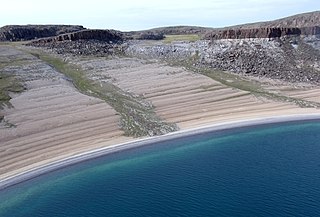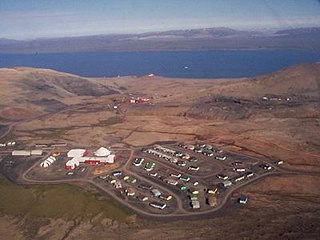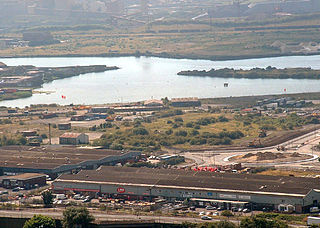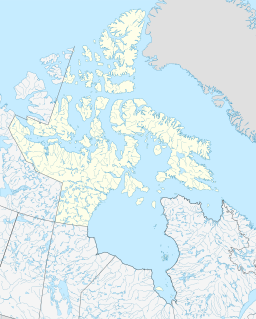
Victoria Island is a large island in the Arctic Archipelago that straddles the boundary between Nunavut and the Northwest Territories of Canada. It is the eighth-largest island in the world, and at 217,291 km2 (83,897 sq mi)1 in area, it is Canada's second-largest island. It is nearly double the size of Newfoundland (111,390 km2 [43,010 sq mi]), and is slightly larger than the island of Great Britain (209,331 km2 [80,823 sq mi]) but smaller than Honshu (225,800 km2 [87,200 sq mi]). The western third of the island lies in the Inuvik Region of the Northwest Territories; the remainder is part of Nunavut's Kitikmeot Region. The population of 2,168 is divided between two settlements, the larger of which is Cambridge Bay (Nunavut) and the other Ulukhaktok.

Pond Inlet is a small, predominantly Inuit community in the Qikiqtaaluk Region of Nunavut, Canada, located on northern Baffin Island. To the Inuit the name of the place "is and always has been Mittimatalik." The Scottish explorer Sir John Ross had named an arm of the sea that separates Bylot Island from Baffin Island as Pond's Bay, and the hamlet now shares that name. On 29 August 1921, the Hudson's Bay Company opened its trading post near the Inuit camp and named it Pond Inlet, marking the expansion of its trading empire into the High Arctic.

First Quantum Minerals is a Canadian-based mining and metals company whose principal activities include mineral exploration, development and mining. Its main product is copper, which accounts for 80% of revenues as of 2016.

Teck Resources Limited, known as Teck Cominco until late 2008, is a diversified natural resources company headquartered in Vancouver, British Columbia, that is engaged in mining and mineral development, including coal for the steelmaking industry, copper, zinc, and energy. Secondary products include lead, silver, gold, molybdenum, germanium, indium and cadmium. Teck Resources was formed from the amalgamation of Teck and Cominco in 2001.

There are an estimated 850 km (530 mi) of roads and highways across the Canadian territory of Nunavut, which is the only province/territory not connected by road to other parts of Canada.

Bathurst Inlet, officially Kiluhiqtuq, is a deep inlet located along the northern coast of the Canadian mainland, at the east end of Coronation Gulf, into which the Burnside and Western rivers empty. The name, or its native equivalent Kingoak, is also used to identify the community of Bathurst Inlet located on the shore. Melville Sound opens into the eastern side of the inlet at Cape Croker, west of the Hurd Islands.

Nanisivik is a now-abandoned company town which was built in 1975 to support the lead-zinc mining and mineral processing operations for the Nanisivik Mine, in production between 1976 and 2002. The townsite is located just inland from Strathcona Sound, about 20 km (12 mi) east of the community of Arctic Bay in the Canadian territory of Nunavut.

The Port of Port Talbot is located on the River Afan estuary next to Port Talbot Steelworks in the industrial town of Port Talbot, South Wales. The whole basin complex covers about 500 acres (2.0 km2), consisting of: an inner set of floating docks, developed from 1834 onwards; and an outer tidal basin, completed in 1970. Owned and operated by Associated British Ports, the tidal basin has the deepest berthing facilities in the Severn estuary and is one of only a few harbours in the UK capable of handling Capesize vessels of up to 170,000 tonnes deadweight (DWT), mostly for the import of iron ore and coal for use by nearby Port Talbot Steelworks.
Ferguson Lake is a lake in Kivalliq Region, Nunavut, Canada. It is located 150 km (93 mi) north of the tree line, midway between Yathkyed Lake and Qamanirjuaq Lake. The lake's outflow is to the east into the Ferguson River, which flows eastward through several lakes, emptying into northwestern Hudson Bay between Rankin Inlet and Whale Cove. The closest community is Baker Lake, 160 km (99 mi) to the north.

Copper Inuit, also known as Inuinnait and Kitlinermiut, are a Canadian Inuit group who live north of the tree line, in what is now the Kitikmeot Region of Nunavut and in the Inuvialuit Settlement Region in the Inuvik Region of the Northwest Territories. Most of them historically lived in the area around Coronation Gulf, on Victoria Island, and southern Banks Island.
The Rae River (Pallirk) is a waterway that flows from Akuliakattak Lake into Richardson Bay, Coronation Gulf. Its mouth is situated northwest of Kugluktuk, Nunavut. Its shores were the ancestral home of Copper Inuit subgroups: the Kanianermiut and the Pallirmiut.

Hornaday River is a waterway located above the Arctic Circle on the mainland of Northern Canada.
The Mary River Mine is an open pit iron ore mine on Inuit Owned Land (IOL) operated by the Baffinland Iron Mines Corporation (BIMC), in the Mary River area of the Qikiqtaaluk Region, on Baffin Island, Nunavut, in the Canadian Arctic Archipelago. As of 2021, Mary River mine operation consists of an open-pit mine, two work camps for hundreds of workers, a tote road—from the Mary River site to Milne Inlet—and a port infrastructure at Milne Inlet. According to a 4-year study published in 2008, the Mary River Mine, with its four massive iron ore deposits of 65-70% pure iron ore was "one of the most promising undeveloped iron deposits on the planet". It was not until technological advances were in place in 2010, and the market for iron ore had dramatically increased that sizable financial backing for the high cost of development in a remote region known for its inhospitable climate, was available. The mine began operations in 2014, and the first shipment to Europe arrived in 2015. Baffinland is currently planning on expanding the mine. In February 2021, a group of Inuit hunters blockaded access to the mine for a week to protest the expansion.
Polaris zinc mine was a former underground mine on Little Cornwallis Island in the Canadian territory of Nunavut. The zinc mine was located 1,120 km (700 mi) north of the Arctic Circle, and 96 km (60 mi) north of the community of Resolute. It closed in July 2002 following more than twenty years of zinc production.

The Nanisivik Naval Facility is a Canadian Forces naval facility on Baffin Island, Nunavut. The station is built at the former lead-zinc mine site near the former company town of Nanisivik. The facility was undergoing final testing in mid-2019. Full operational capability had been expected to be achieved by mid-2020 with the first refuelling of a Royal Canadian Navy ship. However, in July 2020 it was confirmed that work on the facility would not be completed until 2022. On 30 March 2022, it was reported that the completion of the facility would be further delayed to 2023. Then in November 2022, the Auditor General of Canada reported that the facility would start to be used by the navy regularly beginning in 2025.
The Ring of Fire is a vast, mineral-rich region located in the remote James Bay Lowlands of Northern Ontario, Canada. Spanning approximately 5,000 square kilometres (1,900 sq mi), the area is rich in chromite, nickel, copper, platinum group elements, gold, zinc, and other valuable minerals. Discovered in the early 21st century, the Ring of Fire is considered one of the most significant mineral deposits in Canada, with the potential to greatly impact the nation's economy and global mining industry. The development of this region has been a subject of ongoing debate, as stakeholders weigh the economic benefits against environmental concerns and the rights of Indigenous communities in the area. Despite these challenges, the Ring of Fire had remained a focal point for the Canadian mining sector and government, as well as international investors. By July 2023, the federal and provincial governments were no longer in agreement on priorities for federal funding of the Ring of Fire. Georgia Lake lithium project, KGHM's Victoria mine proposal and the Onaping Depth nickel project—which will produce minerals required for the low carbon economy—had become higher priorities, particularly as the Ring of Fire project is situated in a region of "vast, environmentally sensitive...peatlands".
Century Mine was a large open cut zinc, lead and silver mine at Lawn Hill, 250 km (160 mi) northwest of Mount Isa in North West Queensland, Australia. It was Australia's largest open pit zinc mine. Discovered by CRA Limited, mining was initiated by Pasminco, continued by Zinifex, then OZ Minerals and then MMG Limited who mined the project until closure. The property is currently owned by New Century Resources whose primary business is tailings reprocessing.
Nunavik is an icebreaking bulk carrier owned and operated by the Canadian shipping company Fednav. She is used to transport copper and nickel from the Nunavik Nickel Project, making 7–8 round trips per year.
The Bathurst Inlet Port and Road Project is a plan to build an all-weather road from Bathurst Inlet in Nunavut to a complex of mines that are approximately equidistant between Bathurst Inlet and Yellowknife, NWT. There are no paved roads between Yellowknife and the mines, so they have relied on shipping supplies to the mines over winter-time ice roads. However, in 2005, there was a particularly warm winter, and the ice roads weren't safe for a long enough period to bring in supplies.













